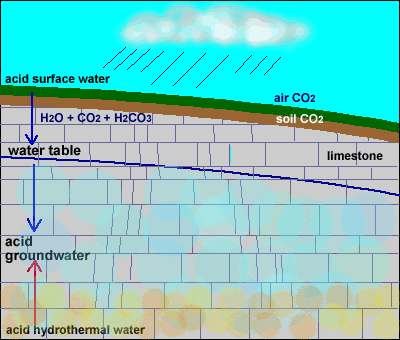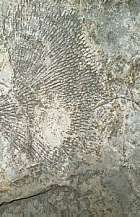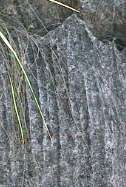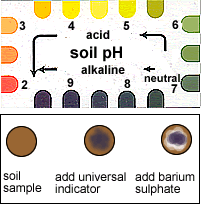Ecosystems at Risk: Limestone caves
4. Landforms: cave formation
Many landforms form from the breaking down of rock (weathering),
the removal of the weathered material (erosion) and the deposition
of the eroded material. Landforms include hills and valleys, floodplains,
beaches and limestone caves.
 |
Cave formation
is dominated by the chemical weathering of limestone rock. When rain
falls, the water absorbs carbon dioxide gas from the air and from
the soil as it infiltrates it. The water then becomes a weak acid,
carbonic acid (H2CO3), which can chemically
weather limestone by dissolving it. The dissolved rock is carried
away as calcium and carbonate ions in the water. Limestone caves form in the groundwater zone where the joints in the rock are filled with water. Groundwater can also come from warm water deep underground, hydrothermal water which is also acidic. |
|
If the water table is lowered and the cave empties of water, it will stop getting larger and speleothems (stalactites etc.) will form. If a stream is left flowing along the cavern floor, normal stream processes of erosion and deposition plus solution, will deepen the stream channel in the cave floor. The limestone forming the sides of the stream will still be weathered by the acidic stream water. In reality, cave formation is much more complex that the above explanation. Individual caves form over very long periods of time and cave forming factors such as the climate, catchment hydrology, vegetation, hydrothermal water and soils change which impact on the height of the water table and the amount of CO2 in the water. Once a cavern has formed and has air space, the deposition of calcite can occur and speleothems (cave formations) such as stalactites and stalagmites can begin to form. |
|
 Fossil in the limestone at Yarrangobilly which formed about 440 million years ago from the shells and skeletons of sea animals and lime muds. |
 Solution flutes caused by rainwater flowing down the rock and dissolving
the limestone (chemical weathering).
Solution flutes caused by rainwater flowing down the rock and dissolving
the limestone (chemical weathering). |
 Soil formed from the limestone parent material is very alkaline.This soil pH test is done by placing 3 drops of universal indicator on the soil sample. The indicator turns a colour depending on the pH. Sprinkle the soil with barium sulphate (a white powder) which allows the colour to develop better. |
| cave formations |